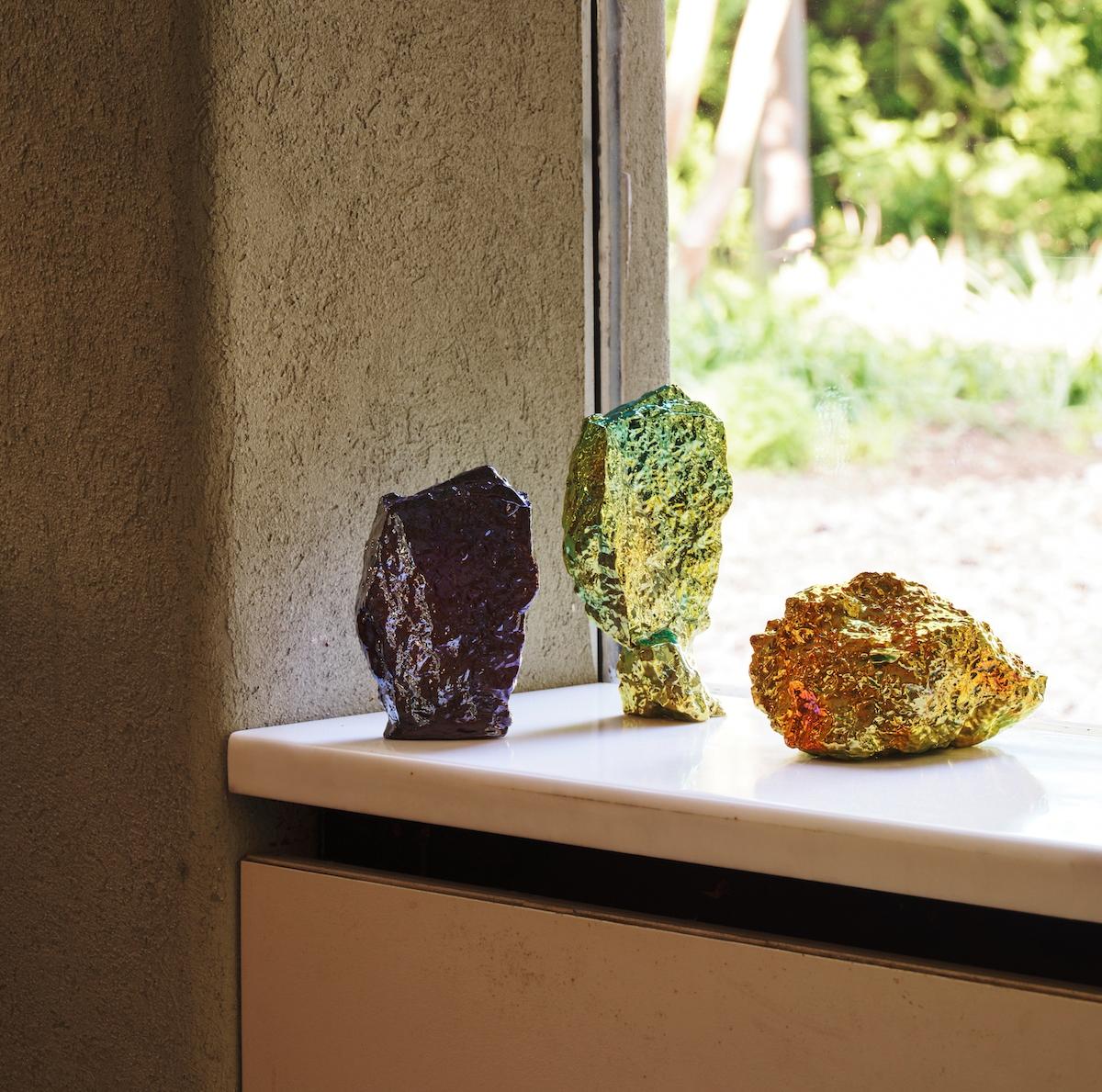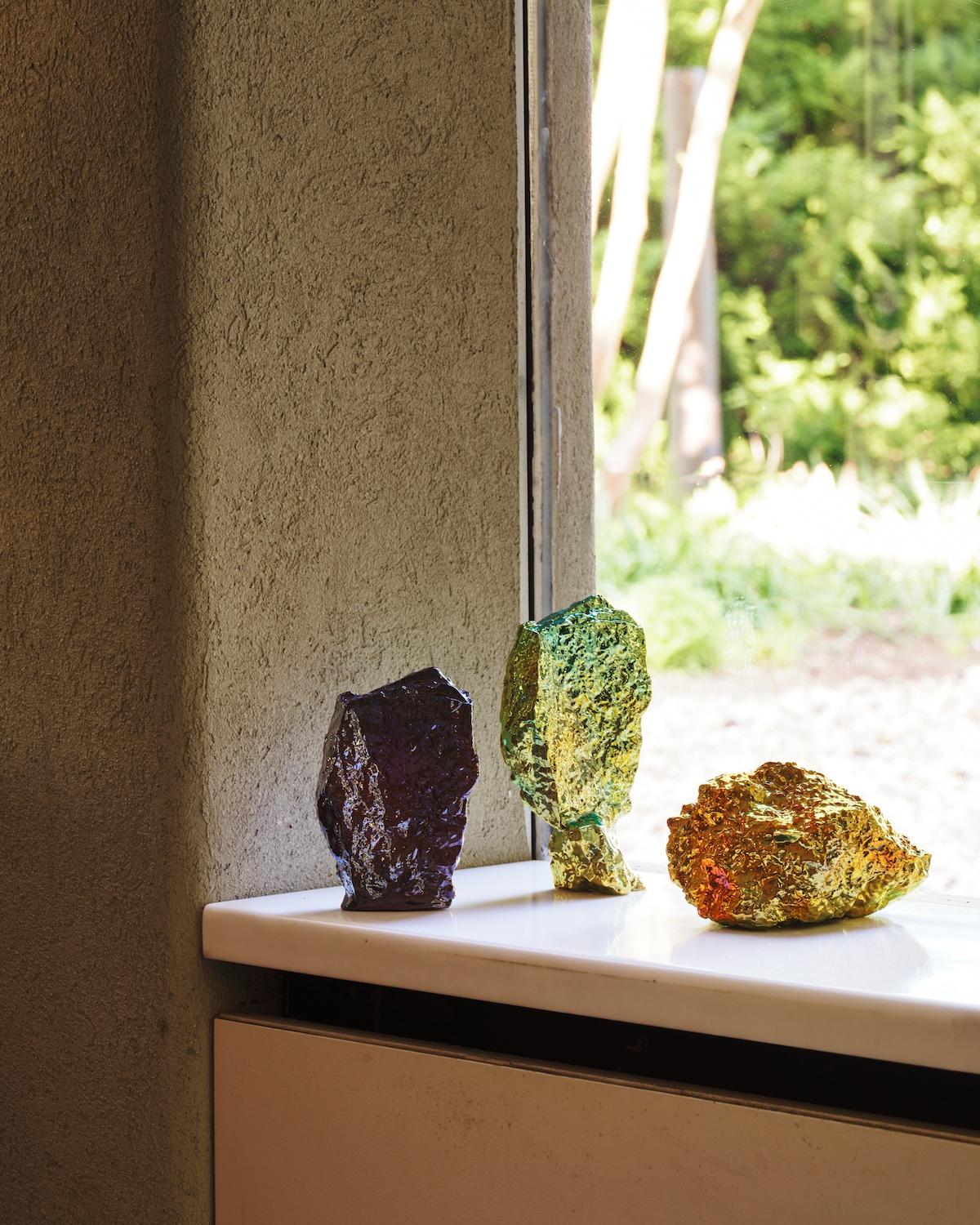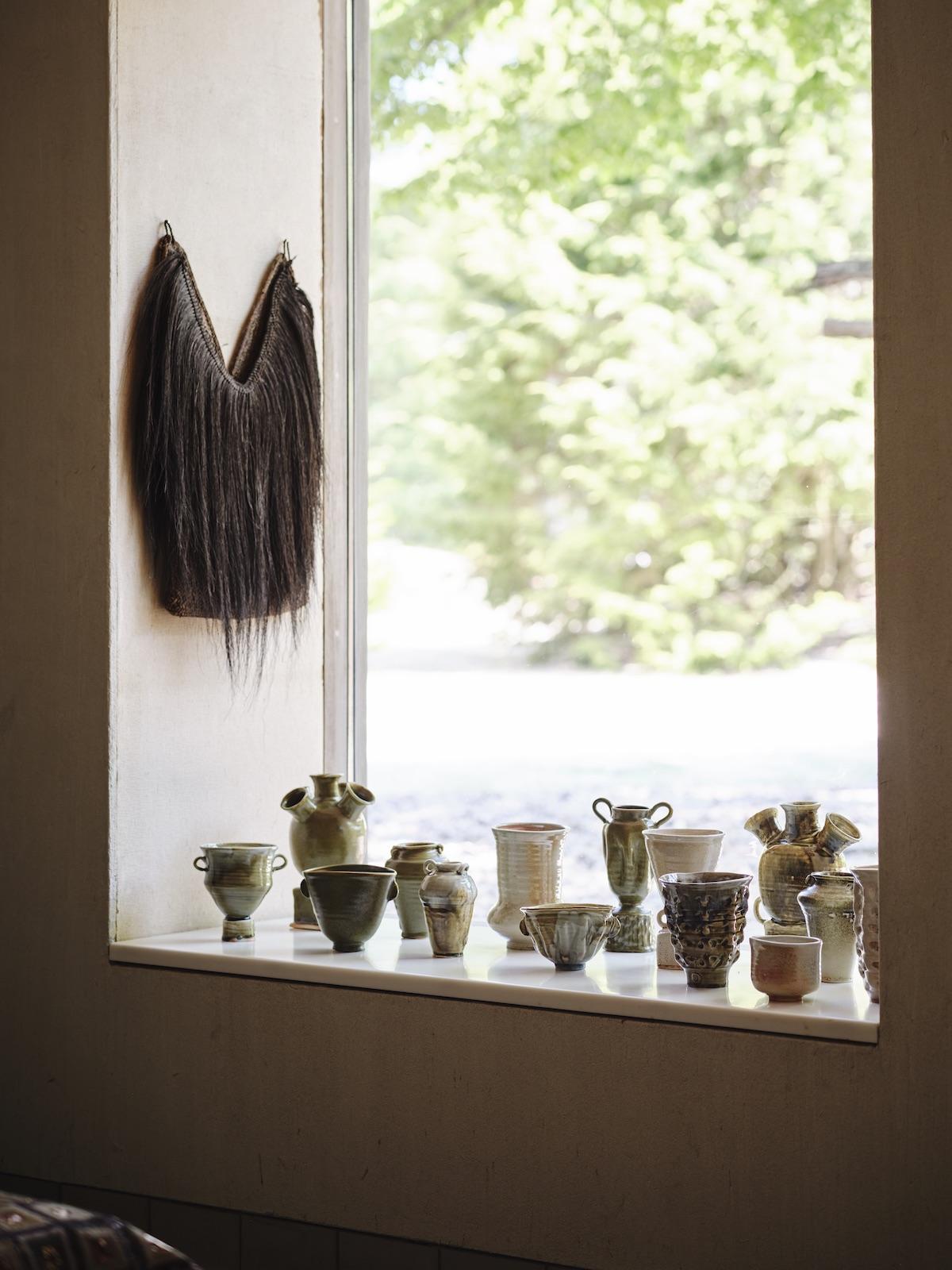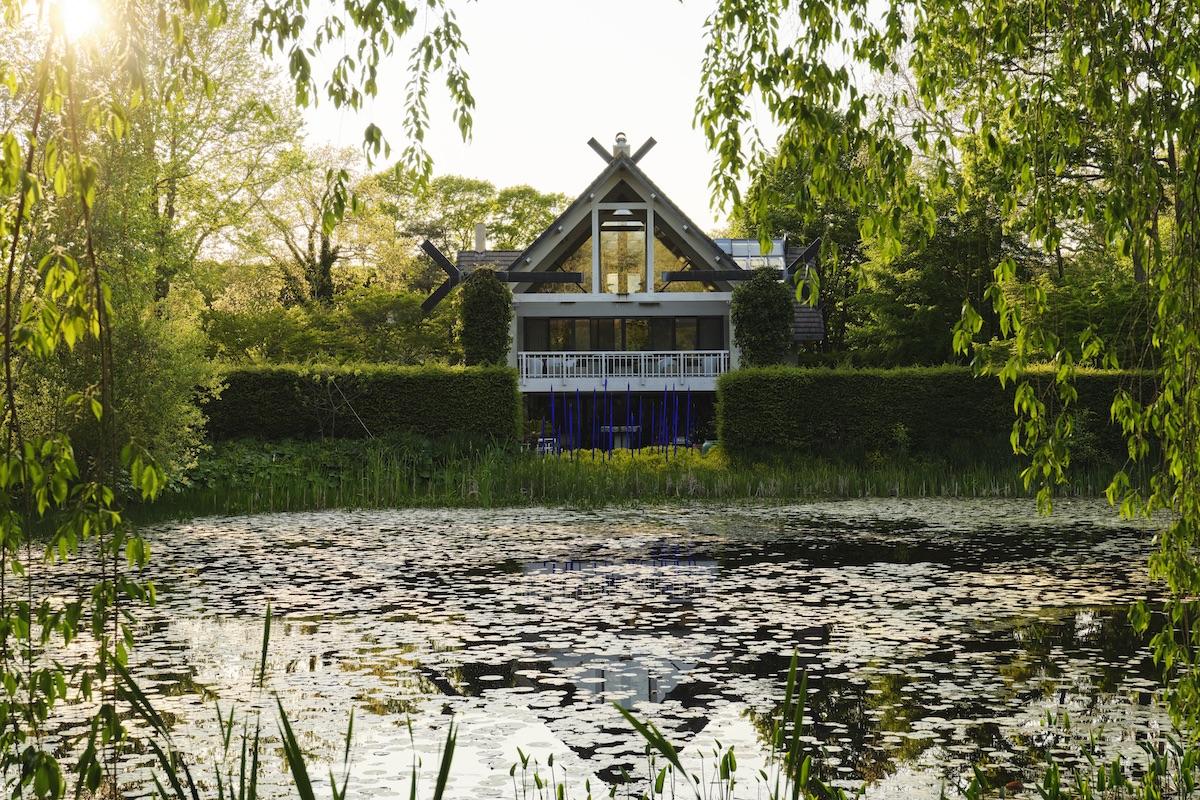LongHouse Reserve is an extraordinary home, and something of a cultural masterpiece in itself. Inspired by the 7th century Shinto shrine at Ise, Japan, Larsen worked with architect Charles Forbergon to design the house, in which Larsen would display his gift for blending art and design that he collected on his travels around the world with simpler objects like shells in an African basket. This show also marks the first time the guest-level of the house has been opened, thanks to LongHouse Director Carrie Rebora Barratt.

A Summer Arrangement: Object & Thing at LongHouse. LongHouse, East Hampton, New York. Works pictured: [left to right] Julia Kunin, Purple Cliff, Green Providence and Fools Gold II (2022).
In this new column, the editors of Art & Object tap people in the art, design, and other cultural industries to select an object of interest from an exhibition, art or design fair, archaeological dig or other venue of choice and tell us why we should care about it.
This summer, while you can see art and design at galleries that have popped up all around the Hamptons, one exhibition incorporates art and design more personally into a home, accentuating the inspired way of living of its creator, the renowned textile designer and collector Jack Lenor Larsen (1927-2020).
A Summer Arrangement: Object & Thing at LongHouse Reserve is an exhibition of new and site-specific contemporary art and design installed within Larsen's East Hampton home and sculpture garden and featuring works by artists and designers including Alma Allen, Megumi Shauna Arai, Julia Kunin, Simone Bodmer-Turner, Sarah Crowner, Sonia Gomes, Rashid Johnson, Wyatt Kahn, and Jennifer Lee. The show is co-curated by LongHouse Curator-at-Large Glenn Adamson, and Object & Thing founder Abby Bangser with features installation design by interiors stylist Colin King.

A Summer Arrangement: Object & Thing at LongHouse. LongHouse, East Hampton, New York. Photo by Adrian Gaut. Works pictured: [left to right] Julia Kunin, Purple Cliff, Green Providence and Fools Gold II (2022).
In light of this special show, which features so many artworks and design objects in exquisite dialogue, we asked Adamson to select an object from the exhibition and tell us something about it.
Glenn Adamson on Julia Kunin's Ceramics:
Julia Kunin’s trio of ceramics, gleaming gloriously in the window at LongHouse, are the result of a rather amazing cross-cultural journey. She calls them scholars’ rocks, alluding to the tradition among Chinese literati of selecting natural stones which can be appreciated for their inherent sculptural qualities. It’s an intriguing aesthetic model, which implies that entirely accidental features can be appreciated in a similar way to how we look at art—and especially appropriate in the context of ceramics, where chance has such an important part to play, thanks to the nature of the firing process."
More explicit than this Asian reference, is the materiality of Kunin’s pieces, which were made during one of her summers in Hungary. She sought out this opportunity mainly because of the amazing luster glazes used there, most famously at the Zsolnay Factory, which rose to international prominence as one of the great producers of Art Nouveau ceramics. The three pieces at LongHouse are cast from actual rocks, and feature different glazes in tones of yellow, green, and purple—though these words don’t come close to capturing the spectacular depth and iridescence of the surfaces, which are that much more visually dynamic because of their irregularity. In a sense they are very simple—found stones, duplicated and then glazed and fired—yet they have the quality of religious relics or personal icons.




![ASummerArrangement_Image 1_Horizontal.jpeg A Summer Arrangement: Object & Thing at LongHouse. LongHouse, East Hampton, New York. Photo by Adrian Gaut. Works pictured: [on wall] Simone Bodmer-Turner, House Painting, Woven Cattails (2023) and House Painting, Woven Lilies (2022–23); [on table] ceramics by Julia Chiang and Jolie Ngo.](https://cdn.artandobject.com/sites/default/files/styles/media_crop/public/asummerarrangementimage-4_0.jpeg?itok=j_hhu3YU)

![ASummerArrangement_Image 11 (1).jpeg A Summer Arrangement: Object & Thing at LongHouse. LongHouse, East Hampton, New York. Works pictured: [window] Sonia Gomes, Tecendo Amanhã III (2016); micaceous clay vessels by Johnny OrtizConcha arranged on a Wharton Esherick table in the collection of LongHouse.](https://cdn.artandobject.com/sites/default/files/styles/media_crop/public/asummerarrangementimage-11-1.jpeg?itok=PF4-yJ5d)
![ASummerArrangement_Image 2.jpeg A Summer Arrangement: Object & Thing at LongHouse. LongHouse, East Hampton, New York. Photo by Adrian Gaut. Works pictured: [left to right on wall] Megumi Shauna Arai, めぐりあ い II and めぐりあい III (2023); [on bed area] two hand-stitched pillows by Kiva Motnyk with pillows from the collection of LongHouse; Cody Hoyt, Untitled Vessel (Curved Walls 02) (2017); [foreground] Rashid Johnson, Untitled Ceramic (2019) on a table by Wharton Esherick from the collection at LongHouse.](https://cdn.artandobject.com/sites/default/files/styles/media_crop/public/asummerarrangementimage-2.jpeg?itok=0dntlUyg)
![Julia_Kunin_ASummerArrangement_Image 21.jpg A Summer Arrangement: Object & Thing at LongHouse. LongHouse, East Hampton, New York. Photo by Adrian Gaut. Works pictured: [on wall] Enrico David, Untitled (2014); [shelves] ceramics by Laird Gough, Ludmilla Balkis and Jennifer Lee; glass Giardino candleholders by Sophie Lou Jacobsen; a wooden stand from the collection at LongHouse.](https://cdn.artandobject.com/sites/default/files/styles/media_crop/public/asummerarrangementimage-5.jpeg?itok=QIZMfgjW)
![ASummerArrangement_Image 17.jpeg A Summer Arrangement: Object & Thing at LongHouse. LongHouse, East Hampton, New York. Photo by Adrian Gaut. Works pictured: [far left] Wharton Esherick chair from the collection of LongHouse; [shelves]; an arrangement of baskets, seed pods, shells and wooden stands from the collection of LongHouse alongside ceramics by Cody Hoyt, Frances Palmer and Raina Lee; [console]; Sophie Lou Jacobsen, Giardino Vase I, II and III (2023); Adam Silverman, Untitled (2019–19).](https://cdn.artandobject.com/sites/default/files/styles/media_crop/public/asummerarrangementimage-17.jpeg?itok=yUyTBhbe)
![ASummerArrangement_Image 18.jpeg A Summer Arrangement: Object & Thing at LongHouse. LongHouse, East Hampton, New York. Photo by Adrian Gaut. Works pictured: [wall] Wyatt Kahn, Untitled, (2021); [console, left to right] Adam Silverman, Untitled (2018–19); objects in the collection of LongHouse.](https://cdn.artandobject.com/sites/default/files/styles/media_crop/public/asummerarrangementimage-18.jpeg?itok=BF7XiHY2)
![ASummerArrangement_Image 12.jpeg A Summer Arrangement: Object & Thing at LongHouse. LongHouse, East Hampton, New York. Photo by Adrian Gaut. Works pictured: [floor] Alma Allen, Not Yet Titled, 2023; [left wall] a site-specific wall shelf by Joseph Walsh for LongHouse entitled Enignum Shelf XXXVI (2019).](https://cdn.artandobject.com/sites/default/files/styles/media_crop/public/asummerarrangementimage-12.jpeg?itok=uK4OuzOO)
![ASummerArrangement_Image 10.jpeg A Summer Arrangement: Object & Thing at LongHouse. LongHouse, East Hampton, New York. Photo by Adrian Gaut. Works pictured: [back wall]: ladder and baskets from the collection of LongHouse with a work by Jeremy Frey on the top rung; [wall] Kiva Motnyk, Light Reflections (2023); [side table] Ludmilla Balkis, Monochrome No. 04, (2021); [bed] Jack Lenor Larsen, Magnum (1970).](https://cdn.artandobject.com/sites/default/files/styles/media_crop/public/asummerarrangementimage-10.jpeg?itok=UVYHaPbi)





















